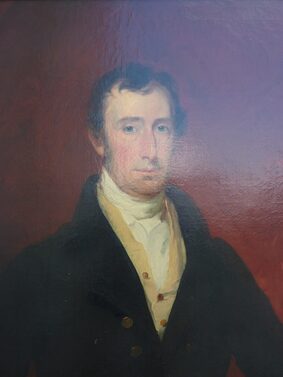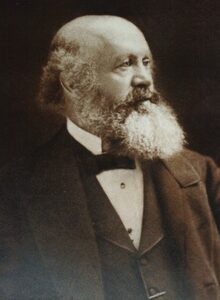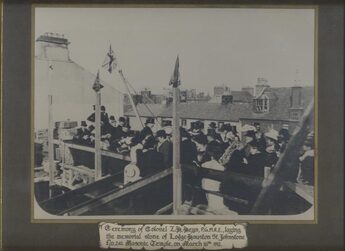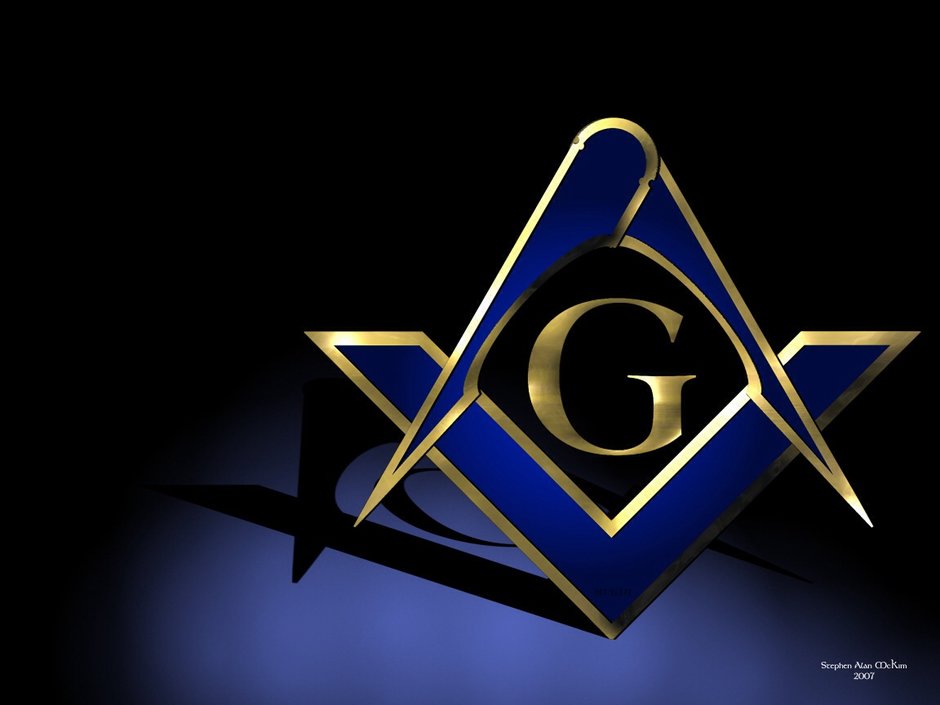Historical Sketch of Houstoun St. Johnstone No.242
On 5th August, 1811 Lodge Houstoun St. Johnstone No.318 received its charter from the Grand Lodge of Scotland. Thankfully, the lodge’s records are complete other than occasional missed minutes. The first master was Bro. William Houstoun Esquire of Johnstone Castle (see photo below) – his occupation was a gentleman. The lodge received the number 318, the next sequential number available. In 1816, Grand Lodge renumbered lodge and it changed to 235 then after the final renumbering exercise in 1826 it became 242. The lodge met in various places in the 19th century. In the first ten years, it was quite common to initiate candidates who owned public houses and then hold meetings in their establishments. The main reason was probably finance – the lodge did not pay a rental and the innkeeper often provided food at his cost.

The founder members of the lodge are listed as follows:
Master William Houstoun Esq. Lodge unknown
Depute Robert Hodgart Largs Kilwinning No.173
WSW Campbell Snodgrass St. James Paisley No.175 (erased 1816)
WJW Alexander Stewart Glasgow St. Mungo No. 27
Secretary Neil Snodgrass St. James Paisley No.175 (erased 1816)
Treasurer George Webster St. Barchan No.156
SD William Black St. Barchan No.156
JD John Robb Greenock St. John’s No. 173 (now 175)
Chaplain William Telfer Lodge unknown, but minister at the High Parish Church
The second meeting, only 10 days after the first, was an important occasion. A deputation from Paisley St. James Lodge (defunct sometime before 1836) visited consisting of the master, wardens, secretary and treasurer to consecrate the new lodge. The lodge paid for their coach hire to Johnstone (12 shillings). The master of Paisley took the chair and swore in the office bearers “after which a considerable number of members were re-entered.” These 19 brethren came from lodges in Paisley, Lochwinnoch, Kilbarchan, Beith, Ayr and Largs. George and Ludovic Houstoun of Johnstone Castle, William’s father and brother were included in this list. In a similar manner to today, the list of occupations is quite varied – surgeon, merchant, plasterer, writer, cotton spinner tin smith and gentleman. One such person was Bro. William Campbell, the well known writer (lawyer) in the town. He had many dealings with the Houstoun family so perhaps affiliating at the same time is not surprising.
The next few meetings were only to initiate or affiliate brethren and December alone had six meetings including Christmas Eve. At one of these, the initiate was Mr. William Lock, the factor of the Houstoun family who would be present at the signing of most contracts with feuers and the family. Bro. Lock, perhaps unsurprisingly, became the secretary (as well as master) and it would appear that he was responsible for supplying the lodge certificate to candidates. In 1832, he paid “fees for not accepting office.” It wasn’t until February that the first two candidates were passed and raised. In these days, it was common to initiate brethren on one night and then pass and raise them on another. Clearly the second and third degrees were much shorter. In all cases, candidates signed the Minute Book to make it binding – no roll book existed at this time.
In November 1812, the new master was chosen, not elected, for the ensuing year. There was no installation ceremony, the master was known as the “Grand Master” and Bro. Neil Snodgrass was given the office of “past master” although he had never been a master – obviously a different title from what we know today. In 1813, articles were drawn up for a Friendly Society to look after indigent brethren and in these very early days of the lodge, this was an important aspect of Masonic life.
In 1828 an inventory was written into the minutes. The lodge was only 17 years old, but it had amassed 25 objects and mostly silver. Many of these would be kept in the Tyler’s chest and for setting out the lodge he was usually paid 2 gills of rum. These appear to include most of the current office bearers’ jewels. Interestingly, it gives a rough idea of regalia worn in the early 1800s. There were ten silk sashes with the letters ‘H.St.J.’ in gold with ten aprons which were painted and gilded. A couple of items are described, but their use has been lost in time. The master has a painted and lettered rod with a triangle on top and there was a canvas oil painting with an attached roller. Why did the master have a rod and was the painting an early tracing board?
Fowler’s Directory for the town in 1851-52 lists the Committee to Town Management (prior to the Town Council). The President and Secretary were PMs, while the Treasurer and four committee members were also lodge members; only three other gentlemen of the Council were not in the lodge. Clearly, the lodge members were active in the town’s affairs and cared about its future. A similar story appears for Justices of the Peace whereby four out of eight were members. This also continued once the burgh was formed with 22 out 30 Town Provosts being members of the lodge.

Between 1855 to 1863, the number of meetings were sparse, if any, but Bro. James Donald PM (above) continued to pay Grand Lodge dues out of his own pocket and therefore, the lodge was never dormant. The lodge owes a real debt of gratitude to Bro. Donald PM. Without his generosity, the lodge would not have been able to celebrate its 200th Anniversary in 2011. Why did the lodge struggle during this period? It would appear that the town of Johnstone was developing into a burgh and many of the brethren were involved in this process as Councillors and Provosts of the town.
Industry was a huge part of Johnstone employing the majority of men. Virtually all owners were members, but two prominent members were John Lang who made lathes (with Sir William Biggart Lang who became Chairman of the Machine Tool Committee of the Minister of Munitions) and Sir William Arrol who constructed bridges (including RMS Titanic's Arrol Gantry) all over the UK.

The lodge went from strength to strength and in 1912, the brethren built their own premises which we celebrated in 2012 by a re-dedication ceremony by the PGL Renfrewshire East. The number of candidates in 1919 was 126 (the highest in any year) and no other year really came close to this number of intrants. The following year, 78 brethren are advanced to Mark Master with 211 attending the meeting. Is this a Masonic record? The varied syllabi of the past had gone and the lodge was only concerned with getting men through degrees.
During the next 20 to 30 years, the lodge functioned very successfully and was also an active participant in all the public affairs of the town. No doubt this was helped through various lawyers, teachers and ministers who were members. The social aspects soon became important and a social club was formed which eventually had its own premises built and continues to be an important aspect for revenue.
Over the past 30 years, the lodge has had degrees exemplified from lodges in, France, the USA, England, and Ireland. The lodge has produced a large number of brethren who have gone onto become masters in other lodges and its newsletter, The Cross Keys magazine named after the premises in which the lodge met, goes far and wide. Our story is not unique in terms of Craft lodges, but we are very proud of freemasonry in Johnstone and as part of The Grand Lodge of Scotland.
The lodge history book can be purchased from the Lodge Secretary.
